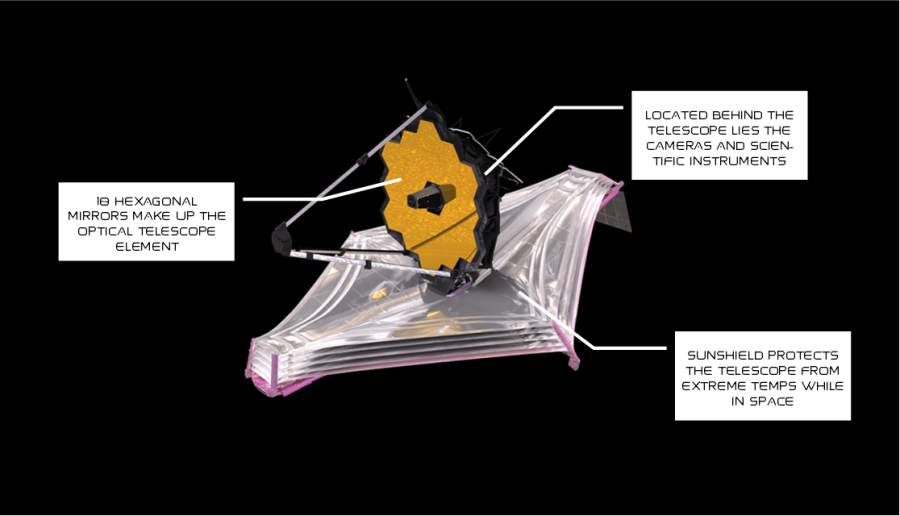WEBB Hopes to discover universe
Latest NASA project begins documenting the great beyond after launch
March 11, 2022
The next generation of space exploration was ushered in with the launch of the James Webb Space Telescope on Dec. 15. The technological marvel will help astronomers study the cosmos and even the beginning of the universe.
The Webb successfully cruised into space aboard a European Space Agency rocket, and it promptly started unraveling origami style and unfurling its main components while traveling at over 700 miles an hour.
After completing its 30-day journey traveling through space, the Webb has arrived at Lagrange point 2, its final destination nearly a million miles away from planet Earth. Now that it has arrived, the most powerful space telescope ever created will begin its 10-year mission documenting space and its many secrets.
The $10 billion project is in a league of its own when it comes to peering deep into space and locating distant galaxies. The primary mirror is nearly three times larger than—and has seven times the light-gathering capability of—its predecessor, the Hubble Space Telescope.
It also sees the universe in infrared light while the Hubble sees the universe primarily through visible light. Observing infrared light will allow astronomers to get a better look at distant celestial bodies that the Hubble cannot view.
Besides its primary mirror, the Webb also comes equipped with a sunshield approximately the size of a tennis court. The sunshield will play a pivotal role in allowing the Webb to carry out its duties.
In order for the Webb to observe the faint infrared light traveling through space, it must stay extraordinarily cold. Because of this, the sunshield will always stay between the telescope and the sun, earth and moon.
On the sunshield side, temperatures will reach as high as 185 degrees Fahrenheit. On the telescope side, the temperatures will dip as low as 388 degrees below Fahrenheit!
If everything goes to plan, the Webb will be able to see through dust clouds surrounding distant stars and their planetary systems. It will also be able to study the atmosphere of exoplanets, determine their habitability for human life, and see the very first glimpses of light in the universe.
However, the Webb will face its fair share of problems while orbiting around the sun.
Unlike the Hubble, the Webb will not be able to be repaired. Thanks to Hubble’s close proximity to Earth, astronauts have been able to make numerous repairs to the spacecraft for more than 30 years and counting.
Because the Webb is traveling so distantly into space, it has no margin for error. That means if anything goes wrong, it could spell catastrophe for NASA and the decades of work and planning the team put into the project.
Thankfully, NASA has learned from the mistakes they made with the Hubble during its 30 years of operation.
To prevent the Webb from experiencing the same issues the Hubble faced, the 18 mirror segments that make up the primary mirror—along with its other systems and operations—underwent comprehensive testing at the Johnson Space Center in Houston before it was launched.
It will be about another 90 days before Webb captures its first photos while it works on aligning its mirrors.
Until then the astronomers, scientists, and engineers who worked on completing the Webb, will be keeping a close eye on its progress from around the world.
This is humanity’s best chance at getting a better understanding of what lies beyond our world and even our solar system. The Webb has the potential to be one of Earth’s greatest scientific achievements—or one of its costliest disasters.
